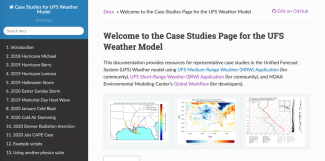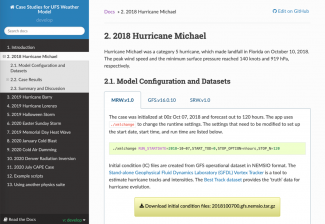The Unified Forecast System (UFS) Case Studies platform offers resources for conducting case studies that represent the evolving forecast challenges of NOAA’s operational Global Forecast System (GFS). This platform is the outcome of a DTC project funded by the 2019 Disaster Related Appropriation Supplemental: Improving Forecasting and Assimilation (DRAS 19 IFAA), also known as NOAA’s Hurricane Supplemental. The platform’s overarching goal is to facilitate the development of model physics innovations and their transitions to operations by exercising the Hierarchical Testing Framework (HTF) coupled with the Common Community Physics Package (CCPP). This project is developing the CCPP capability to output physics tendencies that supports the overall goal. And, leveraging newly developed CCPP capabilities and the CCPP Single Column Model (SCM) to investigate forecast issues using the UFS Case Studies catalog demonstrating to the community how to utilize this platform.
Case studies are an integral component of the HTF as they serve as an entry point for model innovations to be carefully exercised before they can be considered for comprehensive tests that use larger samples. The current set of ten cases covers atmospheric phenomena such as local temperature inversions, hurricanes, winter storms, extreme temperature events, and summertime convection. These cases illustrate forecast issues identified for GFS v16, which has been operational since March 2021. The case catalog was established in collaboration with both the Model Evaluation Group (MEG) at NOAA Environmental Modeling Center (EMC) and colleagues at NOAA Global Systems Laboratory (GSL).
The newly established UFS Case Studies platform includes initial condition (IC) datasets housed on Amazon S3 cloud storage, model configurations, simulation results including the general synoptic patterns and particular meteorological fields that elucidate model issues, and a suite of data-visualization example scripts using Python. Cases included in the UFS Case Studies Platform have been incorporated in the physics testing procedure in the UFS Research to Operation (R2O) Project, which is a multi-year effort that convened NOAA and non-NOAA scientists to work on the operational model.
This platform is designed to serve both the research community and model developers. For researchers, the platform provides resources using the public releases of the UFS Medium-Range Weather (MRW) Application (App) and UFS Short-Range Weather (SRW) App. The SRW App and MRW App target weather predictions on timescales of two weeks and several days, and on limited-area and global domains, respectively. For developers, the platform helps ensure the advanced physics schemes implemented in the next version of the operational model outperform earlier ones. The platform provides information and verification results for the ongoing model development using codes hosted in official UFS GitHub repositories. It is possible to test alternative physics suites composed of different sets of physics parameterizations in addition to the supported suites from the UFS public releases. The platform provides information and links for interested readers with the desired guidance.
In summary, the UFS Case Studies Platform bridges the gap between research and operational communities with resources that foster and advance model development. The platform will continue to evolve as work towards GFS version17 progresses. The UFS Case Studies Team encourages questions, comments, and feedback from users. These can be posted under the Discussions section of the ufs-case-studies GitHub repository.


